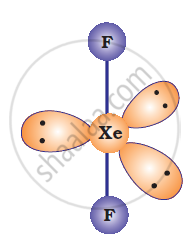Advertisements
Advertisements
प्रश्न
Give the formula and describe the structure of a noble gas species which is isostructural with:
`IBr_2^(-)`
उत्तर १
XeF2 is isoelectronic to `IBr_2^(-)` and has a linear structure.

उत्तर २
IBr2–: In IBr2–, central atom I has eight electrons. Two of these are utilized in forming two single bonds with two Br atom. Six remaining electrons constitutes three lone pairs. It is arranged in linear structure.

IBr2– has 22 valence electrons. A noble gas species having 22 valence electrons is XeF2 (8+2 x 7=22).
XeF2 is also linear.
APPEARS IN
संबंधित प्रश्न
Draw the structures of the following molecules: XeF4
Account for the following:
Helium is used in diving apparatus.
Draw the structures of the following molecules: XeF2
Which noble gas is used in filling balloons for meteorological observations?
Complete the equation : XeF2+PF5 →
Complete the following equations : XeF4 + O2F2→
Draw the structures of the following:
XeO3
test q 1234
Balance the following equation: XeF6 + H2O → XeO2F2 + HF
Why has it been difficult to study the chemistry of radon?
Which one of the following does not exist?
(i) XeOF4
(ii) NeF2
(iii) XeF2
(iv) XeF6
Give the formula and describe the structure of a noble gas species which is isostructural with
`ICI_4^(-)`
Draw the structure of XeF4.
Which of the following fluorides does not exist?
Helium is preferred to be used in balloons instead of hydrogen because it is ____________.
The order of increasing sizes of atomic radii among the elements O, S, Se and As is:
Match List - I with List - II:
| List - I | List - II | ||
| (Species) | (Number of lone pairs of electrons on the central atom) |
||
| (A) | XeF2 | (i) | 0 |
| (B) | XeO2F2 | (ii) | 1 |
| (C) | XeO3F2 | (iii) | 2 |
| (D) | XeF4 | (iv) | 3 |
Choose the most appropriate answer from the options given below:
Which one of the following reactions of xenon compounds is not feasible?
\[\ce{XeF6 + H2O ->[Partial][Hydrolysis] \underline{}\underline{}\underline{}\underline{} + \underline{}\underline{}\underline{}\underline{}}\]
Discuss the trends in electronegativity and atomic radii for elements of group 16 17, 18.
